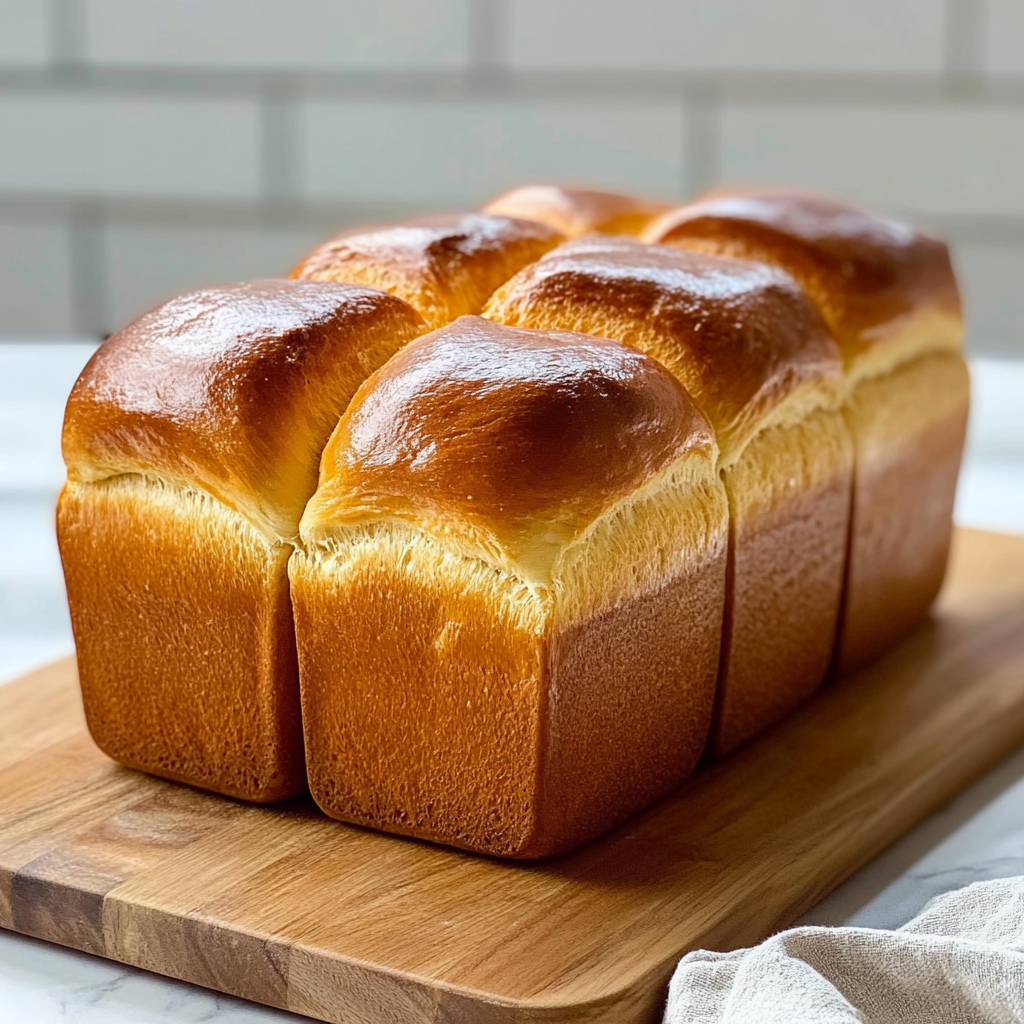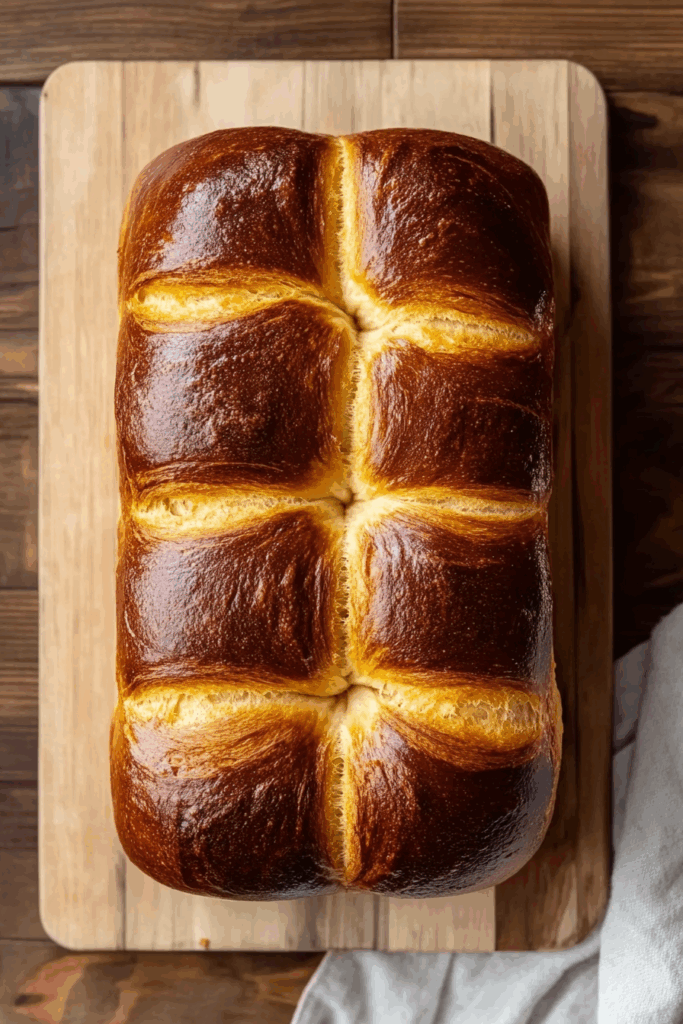Sourdough brioche bread is the ultimate blend of rich, buttery brioche and the tangy complexity of sourdough fermentation. It’s pillow-soft, golden, and incredibly satisfying to pull apart.

This artisan-style loaf takes time, but the result is well worth the wait—perfect for breakfast slices, French toast, or even an elevated sandwich.
Key Players in This Buttery Masterpiece
- Sourdough Starter (Levain) – The natural leavening force that infuses the bread with complex flavor and signature tang.
- Bread Flour – Delivers the strong gluten structure needed to support all that butter and give a light, airy crumb.
- Eggs – Enrich the dough, providing golden color and a tender, almost cake-like texture.
- Whole Milk – Adds softness and helps develop a supple, luscious dough.
- Unsalted Butter – The soul of brioche, bringing a velvety richness that makes every bite melt in your mouth.
- Granulated Sugar – A touch of sweetness that balances the sourdough tang and enhances browning during baking.
- Sea Salt – Accentuates the flavors and rounds out the sweetness with just the right savory contrast.
From Starter to Golden Loaf: How to Make Sourdough Brioche Bread
Begin by building your levain and preparing the yudane, a Japanese method of pre-gelatinizing flour that makes the final bread ultra-soft.
Once both components are ready, mix your dough without butter first—this helps build strength early on. Then, gradually incorporate room-temperature butter in pieces, allowing each addition to fully absorb before adding more.
Knead the dough until it’s smooth, shiny, and passes the windowpane test. Let it bulk ferment at a warm room temperature with stretch and folds to develop structure. Then refrigerate the dough overnight to deepen the flavor and make shaping easier.
The next day, divide the chilled dough into four equal parts. Roll each into a cylinder and nestle them into a prepared loaf pan. Allow a final proof until the dough doubles and feels airy to the touch.
After a glossy egg wash, bake at 350ºF until the loaf is deeply golden and reaches an internal temperature of 195–205ºF. Let it cool before slicing for the cleanest, fluffiest results.
Pro Tips for the Dreamiest Sourdough Brioche
Patience is key—this dough loves time. Each fermentation step enhances the flavor and texture. Don’t rush the bulk or final proof. The yudane technique may seem extra, but it’s worth it for that ultra-soft crumb.
If your kitchen runs cold, place your dough in a turned-off oven with the light on or use a proofing box to maintain that sweet spot around 78ºF. And when incorporating butter, be methodical—adding it too fast can cause the dough to separate or break down.
Experiment by adding orange zest, chocolate chips, or herbs to create sweet or savory twists on this versatile base recipe.

Leftovers That Stay Lush: Storing Sourdough Brioche
Sourdough brioche keeps beautifully at room temperature for up to three days, wrapped tightly in foil or stored in an airtight container. For longer storage, slice and freeze individual pieces for quick, toast-ready breakfasts.
To reheat, pop slices in a toaster or warm the whole loaf in the oven at 300ºF for 10 minutes. Avoid the fridge—it dries out the delicate crumb. A bit of butter on a warm slice will bring this rich bread back to life, even days after baking.

Sourdough Brioche Bread
Ingredients
Levain
- 30 g warm water
- 30 g bread flour
- 30 g sourdough starter
Yudane
- 58 g boiling water
- 58 g bread flour
Dough
- 5 g sea salt
- 59 g whole milk room temperature
- 2 eggs
- 113 g unsalted butter softened
- 27 g granulated sugar
- 212 g bread flour
- Levain prepared as above or substitute 90g of active sourdough starter
- Yudane prepared as above
Egg Wash
- 1 tsp water
- 1 egg
Instructions
- Prepare the levain by combining sourdough starter, bread flour, and warm water in a sanitized jar. Seal and place in a warm area for approximately five hours until bubbly and expanded. Alternatively, use 90 grams of an active sourdough starter directly in the dough.
- Simultaneously, create the yudane. In a small heatproof bowl, mix the bread flour with boiling water. Stir vigorously until a gelatinous paste forms. Allow to cool completely before use.
- When the levain has matured, assemble the dough. In a stand mixer fitted with a dough hook, combine all dough components except butter. Begin mixing at a low speed until a rough mass forms. Increase to medium speed and knead for roughly five minutes until the dough becomes more cohesive and detaches from the bowl’s edges.
- Gradually incorporate the butter, adding one piece at a time while mixing on medium speed. Wait at least a minute or two between additions, ensuring each piece is fully blended. Continue mixing for an additional five minutes post incorporation until the dough is smooth, elastic, and passes the windowpane test.
- Transfer dough to a clean bowl, shape into a round, cover, and let it ferment for about five hours at 78°F. After one hour, perform a set of stretch and folds. Repeat after the second hour if needed to build strength.
- Refrigerate the dough for a slow fermentation overnight, lasting a minimum of eight and up to 48 hours.
- Next day, grease a loaf pan. Punch down the chilled dough, transfer to a lightly floured surface, and divide into four equal portions (approximately 170–175g each). Flatten each into a rectangle, roll tightly from the short end, and place seam-side down in the pan.
- Allow the shaped dough to proof a final time in a warm spot for about five hours at 78°F. The dough should double in size and respond to a gentle poke with a slight indentation.
- Preheat oven to 400°F. Prepare an egg wash by beating an egg with water and brush it lightly over the risen dough. Insert the loaf into the oven, then immediately reduce the temperature to 350°F. Bake for 45 minutes, or until the top is golden and the internal temperature reads between 195°F and 205°F.
- Let the bread rest in the pan for five minutes post-baking, then remove and cool completely on a wire rack for at least an hour before slicing or pulling apart.
